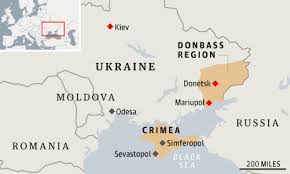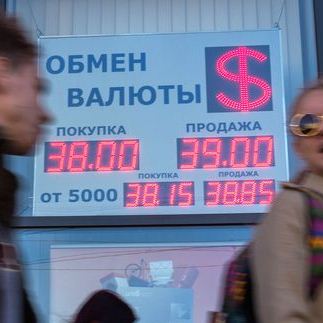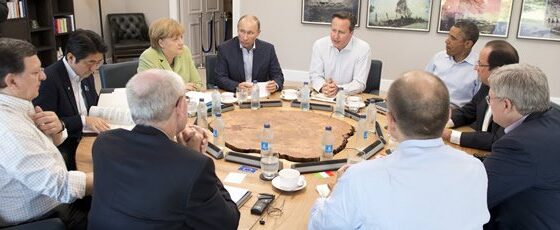(Guest post by Andreas Umland) In a well-researched and -referenced recent policy memo for PONARS Eurasia titled “Domestic Sources of the Donbas Insurgency,” Baylor University’s post-Soviet politics expert Serhiy Kudelia makes an interesting argument for considering the “Ukraine Crisis” not only and not so much, in terms of Russian mingling. Instead, Kudelia underlines the local foundations of the radicalized separatism, political escalation and large-scale violence that led to a full-scale war, in the Donets Basin, in summer 2014. Kudelia cites comparative and theoretical arguments developed earlier and with reference to other cases, by reputed social scientists. He mentions a number of important names and pertinent events relevant to an understanding of the unravelling of the conflict, and refers to properly sociological opinion polls illustrating the specifics of, and changes in, the political culture of the Donbas, in 2014. Based on such references, comparisons and observations, he develops a pointedly academic argument in order to attack interpretations that emphasize the Kremlin’s role in the escalation, weaponization and brutalization of the conflict since early 2014. While Kudelia never mentions the construct “civil war,” his argument could be read as arguing to understand the Donbas insurgency in mainly – though not exclusively – these terms.
Kudelia’s call to not disregard the role of considerable grievances of the Donbas’s population as well as various deficiencies and mistakes of the Ukrainian state, in the emergence of the conflict, is as such apt and important. He provides an informative account which should help students of the recent events in Eastern Ukraine to better comprehend the interplay of various factors leading to the insurgency. Yet, his overall diagnosis is contradictory, and could mislead readers who would only or mainly rely on Kudelia’s interpretation of the Donbas war’s origins. While Kudelia proposes, in this memo, a demonstratively politological argument, paradoxically, his analysis remains ultimately anti- or apolitical. In spite of citing relevant political science literature and listing many political facts about the region, he does not explain or, at least, indicate what the concrete politics of the armed uprising were or could have been. The reason for that omission is simple: There is no comprehensive story of a purely locally based uprising to tell, as the involved political actors from the Donets Basin were few and marginal, if not farcical. The Donbas insurgency was an only partially domestic event. Instead, it was to considerable degree, initiated, directed, supported and organized by Moscow – in some regards, quite openly so by such Russian activists as Igor Girkin (“Strelkov”) or Aleksandr Borodai. Kudelia’s attack on those suspecting a “clandestine organization coordinated from a single center” is defeated by Kudelia’s own apolitical narrative. He proposes to explain a manifestly political incident without presenting or being able to present the political agents, leaders, mobilization, organizations, and resources that supposedly brought about this local incident.
To be sure, the facts, juxtapositions and arguments proposed by Kudelia are by themselves certainly of interest and well-presented. They should enter a full assessment of the emergence of the war. His observations, quotations and considerations are, by as such, valuable, relevant and correct. Yet, the summary picture that Kudelia paints in his text is unfinished. Though mentioning Russian “external prodding,” it overemphasizes existing tensions in the Donbas, and could thus misdirect readers unfamiliar with current Ukrainian history. What are some paradoxes of Kudelia’s narrative?
1. As this is a policy memo, Kudelia starts his argument with some outspoken statements by diplomats who see the Kremlin as the predominant culprit, if not only relevant factor, in the escalation of violence, in Eastern Ukraine. He proceeds from these statements to make his counter-argument about the conflict’s weighty domestic foundation. While the quotes by current and former US diplomats may be of historic interest, they are made by particpants rather than anlysts of the events surrounding the war. They are thus of only limited relevance to a scholarly discussion of the matter.
It is not surprising that statements by public figures are of a partisan nature. As these celebrities are no political scientists, one should not expect from them particularly balanced statements. Most academic analysts would obviously paint a more even picture emphasizing the interplay between the domestic sources and foreign impulses of the Donbas insurgency, and the Kremlin’s skillful use of local tensions. Few scholars would disagree with Kudelia’s statement: “Monocausal explanations pointing to Russia as the sole culprit miss crucial domestic drivers of the insurrection.”
2. While mentioning the Crimea annexation, Kudelia oddly does not treat Russia’s takeover of the Black Sea peninsula as an event directly precursing the Donbas insurgency. As we now know, there was a covert Russian operation to annex Crimea, in February-April 2014. And the pro-Russian uprising on Donbas shortly later was something principally different?
3. The Donbas’s population’s current grievances as well as the institutional defects of the Ukrainian state that Kudelia focuses on are indeed deep, and well outlined as well as contextualized in his policy memo. Yet, it still seems an open question whether they are historically and comparatively salient enough in order to explain by themselves an escalation of tensions leading to outright war. Given the role that Kudelia assigns to the peculiarities of the Donbas’s political culture and situation for the violent insurgency, it could be seen as surprising that this year’s war was not preceded by any significant political violence in Donets Basin before, and that similar wars do not occur more frequently across the globe. The factors that Kudelia lists – i.e. fear, resentment, fragmentation, illegitimacy etc. – as well as their combination are not as rare phenomena in world politics, as one might conclude from his account. The late and post-Soviet Ukrainian state experienced politically and economically turbulent times and nationalist upsurges, in both, the 1990s and 2000s. Yet, never had these also considerable tensions triggered anything closely resembling the armed uprisings of 2014.
To be sure, already the violence in Kyiv in January-February 2014 as well as the government-building seizures in the regions were novel to post-Soviet Ukraine, and might thus be seen as steps towards the East Ukrainian brutalization, as Kudelia apparently suggests. Indeed, violence was used not only by the Yanukovych government, but also by protesters. In particular, the use of not only sticks and stones, but also Molotov Cocktails (criticized by myself publicly during the Euromaidan) and, in some singular cases, even guns by the protesters was a fateful development. Still, most of the victims of the violence during the Euromaidan had been anti-governmental demonstrators, and most of the perpetrators of violent acts were representatives of the ancien regime. The scare that the Central and West Ukrainian events created among russophones in Southern and Eastern Ukraine may have had more to do with the Kremlin’s ongoing information war than with homegrown resentment or the secondary violence used by Euromaidan activists against the Berkut special police forces.
4. A somewhat similar issue is the alleged role of the so-called Right Sector and general right-wing extremism for the organization and radicalization of the Euromaidan. This topic has been discussed, over the last months, in dozens of more or less emotional exchanges, among Western and Ukrainian observers. Some recent commentators on Ukraine’s post-Soviet radical right like Volodymyr Ishchenko (Kyiv-Mohyla Academy), Ivan Katchanovski (University of Ottawa), Gordon M. Hahn (Center for Strategic and International Studies, Washington, DC) or Stephen D. Shenfield (Brown University, Rhode Island) seem to assign a central role to the ultra-nationalists on the Euromaidan, or at least to its radicalization. This view is opposed by more narrowly focused students of post-Soviet Ukraine’s extreme right who have written and edited, or are currently preparing larger publication projects (scholarly monographs, articles series, or journal special issues) dealing, with the post-Soviet Ukrainian party-political ultra-nationalism. Among them are Tetiana Bezruk (Kyiv-Mohyla Academy), Artem Yovenko (University of Jena), Alina Polyakova (University of Bern), Lenka Bustikova (Arizona State University), Anton Shekhovtsov (University College London), Viacheslav Likhachev (Euro-Asian Jewish Congress, Jerusalem) and myself (Institute for Euro-Atlantic Cooperation, Kyiv) – here listed by increasing age. These researchers have taken a less alarmist view of, and assigned a relatively minor role to, Ukrainian right-wing extremists in the recent events at Kyiv.
Both the extensive public and the heated academic discussions around the Right Sector were, not the least, responses to the media hysteria that Russia’s TV propaganda channels created around Yarosh & Co. At some point, the Right Sector was almost as many times mentioned on Kremlin-controlled television, as Russia’s ruling United Russia party. What, in spite of such attention, remained largely unmentioned, in Russian and Western reporting, was that significant parts of the Right Sector’s early leadership came from Southern and Eastern Ukraine, and that some of the local organizations using the label “Right Sector” partially and even predominantly communicate in Russian language. This does not nullify the problematic or even disgusting political views that many (but apparently not all) members of the Right Sector seem to hold. Yet, the apparently significant participation of russophones in the Right Sector does not fit the popular image of an existential conflict between Ukraine’s Russian-speaking East and Ukrainian-speking West. Arguably, it was the Kremlin’s horror image of an allegedly genocidal and ethnocentrist Right Sector, an integral part of Moscow’s “hybrid” or “non-linear war” against Ukraine, rather than the really existing Right Sector that played its role in the spread of fear among many russophones in the Donbas and Crimea. To see this factor as a solely domestic source of the insurgency would be wrong.
5. Kudelia’s mentioning of the local uprisings in Western and Central Ukraine, during the Euromaidan, as events previewing the armed insurgency in the Donbas shortly later is relevant, but may be misunderstood too. As with the putatively triggering function of the Euromaidan violence in Kyiv, the line of continuity between the revolutionary seizures of governmental buildings in Central and Western Ukraine, and the armed insurgency in the Donbas is only partial, if not spurious. The earlier take-overs of administrations were directed against one particular Ukrainian political regime and not against the Ukrainian state. They did not lead to large death tolls, and used physical violence only to a relatively limited degree. The Donbas insurgency may have, in its early phase, copied the events further west. But, in distinction, it became soon directed against the Ukrainian state as such, and quickly informed by the use of increasingly heavy guns.
6. For a political scientist, the most paradoxical aspect of Kudelia’s Donbas insurgency story is the absence of significant local political agency, leadership, organization and support in the chain of events leading to the war. In the Donets Basin, we are told, there happened an arguably world-political event without any real politics, i.e. publicly known politicians, parties, forums, sponsors etc., playing much of a role? On Crimea, at least, there were, within the Kremlin’s secession operation, some locally known politicians and moderately significant organizations directly involved in implementing the annexation, on the ground. In the Donbas, in contrast, not a single truly relevant local politician, public figure, political party, or NGO seems to have been involved, on the spot, in the instigation, guidance, and support of the tragic events that eventually led to war. Kudelia writes much about the Donbas societal peculiarities and Ukrainian state’s deficiencies as factors that would explain the violent uprising. He mentions a few minor pro-Russian groupings. But it remains unclear who, from the Donbas political party spectrum and Donetsk or Luhansk notabilities, had the political authority, weight, skills and resources to translate the doubtlessly existing grievances into sustainable political action the result of which has become nothing less than the establishment of two heavily armed pseudo-states, the so-called “People’s Republics” of Donetsk and Luhansk.
Kudelia himself illustrates this surreal situation when admitting that “[t]he significance of leaders in launching a separatist insurrection in the Donbas […] remains dubious. […] None of the groups involved in staging the rallies—Russian Bloc, Donetsk Army Volunteers, Lugansk Guard, etc.—had serious organizational or financial resources to fund the movement. At the same time, there has never been any conclusive evidence proving that the movement was funded by wealthy PR leaders such as Yanukovych or Rinat Akhmetov. […] [T]he regional political elite, including members of regional councils and city councils, largely refused to support the separatist movement despite demonstrators’ attempts to gain their endorsement. As a result, new regional self-declared councils included mainly random people chosen from among the demonstrators.”
Apart from my unhappiness about Kudelia giving an incomplete impression about the nature of the Donbas insurgency, I support and commend his effort to put these events into a comparative politological perspective and apply political theory to their assessment. I am afraid though that a comprehensive investigation leading to a proper assessment of these events may not in all respects be provided only via a traditional political science project, but could rather amount to a partially criminological undertaking. The main individual and collective actors directing these events, I suspect, will be found, after all, in Moscow rather than Donetsk or Luhansk. Had Kudelia made, at least, an indication in that regard, his otherwise informative text would have been an unreservedly welcome and entirely useful contribution.
Andreas Umland is a Senior Research Fellow at the Institute for Euro-Atlantic Cooperation, Kyiv, and General Editor of the book series “Soviet and Post-Soviet Politics and Society” published by ibidem Press, Stuttgart.
See PONARS Eurasia Policy Memo No. 351 by Serhiy Kudelia, "Domestic Sources of the Donbas Insurgency" (PDF).











